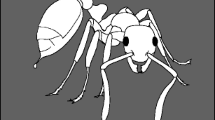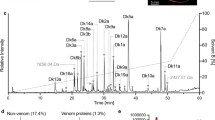Summary
Species of the cosmopolitan ant genus Monomorium are small, slow-moving and non-aggressive ants that are extremely successful members of diverse Australian ant communities. Unlike other abundant taxa, they have no obvious specializations enabling them to co-exist with the highly aggressive species of Iridomyrmex that dominate these communities. Here we report results which suggest that Monomorium species owe their success to the topical application of venom alkaloids which repel other ants. The venom alkaloids (trans-2-ethyl-5-undecylpyrrolidine and trans-2-ethyl-5-tridecylpyrrolidine) of Monomorium “rothsteini” were identified and synthesized, and the repellency to other ants of the synthetic alkaloids were tested using bioassays involving the attraction to honey baits of three native species of Iridomyrmex, three tropical “tramp” species, and M. “rothsteini” itself. Repellency to all other ant species was total or nearly so, but only partial to M. “rothsteini”. Defensive alkaloids produced from a variety of glands are found in other ant genera, and may be a potent yet poorly appreciated force in interference competition between ant species and thereby the structure of ant communities.
Similar content being viewed by others
References
Adams EA, Traniello JFA (1981) Chemical interference competition by Monomorium minimum (Hymenoptera: Formicidae). Occologia 51:265–270
Andersen AN (1983) Species diversity and temporal distribution of ants in the semi-arid mallee region of northwestern Victoria. Aust J Ecol 8:127–137
Andersen AM (1984) Community organization of ants in the Victorian mallee. Vict Nat 101:248–251
Andersen AN (1990) The use of ant communities to evaluate change in Australian terrestrial ecosystems: a review and a recipe. Proc Ecol Soc Aust 16:347–357
Andersen AN (1991a) Sampling communities of ground-foraging ants: pitfall catches compared with quadrat counts in an Australian tropical savanna. Aust J Ecol (in press)
Andersen AN (1991b) Responses of ground-foraging ant communities to three experimental fire regimes in a savanna forest of tropical Australia. Biotropica (in press)
Andersen AN (1991c) Seed harvesting by ants in Australia. In: Culver DC, Hyxley CR (eds) Ant-Plant Interactions, Oxford University Press, Oxford (in press)
Andersen AN (1992) Regulation of momentary diversity by dominant species in exceptionally rich ant communities of tropical Australia. Am Nat (in press)
Andersen AN, Yen AL (1985) Immediate effects of fire on ants in the mallee of northwestern Victoria. Aust J Ecol 10:25–30
Baroni Urbani C, Kannowski PB (1974) Patterns in the red imported fire ant settlement of a Louisiana pasture: some demographic parameters, interspecific competition, and food sharing. Environ Entomol 3:755–760
Blum MS (1985) Alkaloidal ant venoms: chemistry and biological activities. In: Hedin PA (ed) Bioregulators for Pest Control, American chemical Society, Washington DC, pp 393–408
Blum MS, Everett DM, Jones TH, Fales HM (1991) Arthropod natural products as insect repellents. In: Hedin PA (ed) Naturally Occurring Pest Bioregulators, American Chemical Society, Washington DC, pp 14–26
Blum MS, Jones TH, Lloyd HA, Fales HM, Snelling RR, Lubin Y, Torres J. (1985) Porson gland products of Solenopsis and Monomorium species. J Entomol Sci 20:254–257
Bolton B (1987) A review of the Solenopsis genus-group and revision of Afro-tropical Monomorium Mayr (Hymenoptera: Formicidae). Bull Brit Mus (Nat Hist) Entomol 54:263–452
Braekman JC, Daloze D, Pasteels JM, Van Hecke P, Declercq JP, Sinnwell V, Francke W (1987) Tetraponerine-8, an alkaloidal contact poison in a Neoguinean pseudomyrmecine ant, Tetraponera sp. Z Naturforsch 42:627–630
Briese DT, Macauley BJ (1981) Food collection within an ant community in semi-arid Australia, with special reference to seed harvesters. Aust J Ecol 6:1–19
Davison EA (1982) Seed utilization by harvester ants. In: Buckley RC (ed) Ant-Plant Interactions in Australia, W Junk Press, The Hague, pp 1–10
Ettershank G (1966) A generic revision of the world Myrmicinae related to Solenopsis and Pheidologeton (Hymenoptera: Formicidae). Aust J Zool 14:73–171
Greenslade PJM (1976) The meat ant Iridomyrmex purpureus (Hymenoptera: Formicidae) as a dominant member of ant com unities. J Aust Ent Soc 15:237–40
Greenslade PJM (1979) A Guide to Ants of South Australia. South Australia Museum, Adelaide
Greenslade PJM, Halliday RB (1983) Colony dispersion and relationships of meat ants Iridomyrmex purpureus and allies in an arid locality in South Australia. Ins Soc 30:82–99
Greenslade PJM, Greenslade P (1989) Ground layer invertebrate fauna. In: Noble JC, Bradstock RA (eds) Mediterranean Landscapes in Australia: Mallee Ecosystems and Their Management, CSIRO and ANU Press, Canberra, pp 266–284
Hölldobler B (1973) Chemische Strategie beim Nahrungserwerb der Diebsameise (Solenopsis fugax Latr.) und der Pharaomeise (Monomorium pharaonis L.). Oecologia 11:371–380
Hölldobler B (1982) Interference strategy of Iridomyrmex pruinosum (Hymenoptera: Formicidae) during foraging. Oecologia 52:208–213
Hölldobler B, Stanton RC, Markl H (1978) Recruitment and food-retrieving behaviour in Novomessor (Formicidac, Hymenoptera) I. Chemical signals. Behav Ecol Sociobiol 4:163–181
Howard DF, Blum MS, Jones TH, Tomalski MD (1982) Behavioural responses to an alkylpyrazine from the mandibular gland of the ant Wasmannia auropunctata. Ins Soc 29:369–374
Jones TH, Blum MS, Fales HM (1982a) Ant venom alkaloids from Solenopsis and Monomorium species: recent developments. Tetrahedron 38:1949–1958
Jones TH, Blum MS, Howard RW, McDaniel CA, Fales HM, DuBois MB, Torres J (1982b) Venom chemistry of ants in the genus Monomorium. J Chem Ecol 8:285–300
Jones TH, Blum MS, Andersen AN, Fales HM, Escoubas P (1988) Novel 2-ethyl-5-alkylpyrrolidines in the venom of an Australian ant of the genus Monomorium. J Chem Ecol 14:35–45
Jones TH, Blum MS, Escoubas P, Musthak Ali TM (1989) Novel pyrrolidines in the venom of the ant Monomorium indicum. J Nat Prod 52:779–784
Stetter H, Kuhlmann H (1974) Addition von aldehyden an activierte doppelbindungen, VI. Tetrahedron Lett 1974:4505–4508
Wilson EO, Taylor RW (1967) The ants of Polynesia (Hymenoptera: Formicidae). Pacific Ins Mon 14:1–109
Author information
Authors and Affiliations
Rights and permissions
About this article
Cite this article
Andersen, A.N., Blum, M.S. & Jones, T.H. Venom alkaloids in Monomorium “rothsteini” Forel repel other ants: is this the secret to success by Monomorium in Australian ant communities?. Oecologia 88, 157–160 (1991). https://doi.org/10.1007/BF00320805
Received:
Accepted:
Issue Date:
DOI: https://doi.org/10.1007/BF00320805




